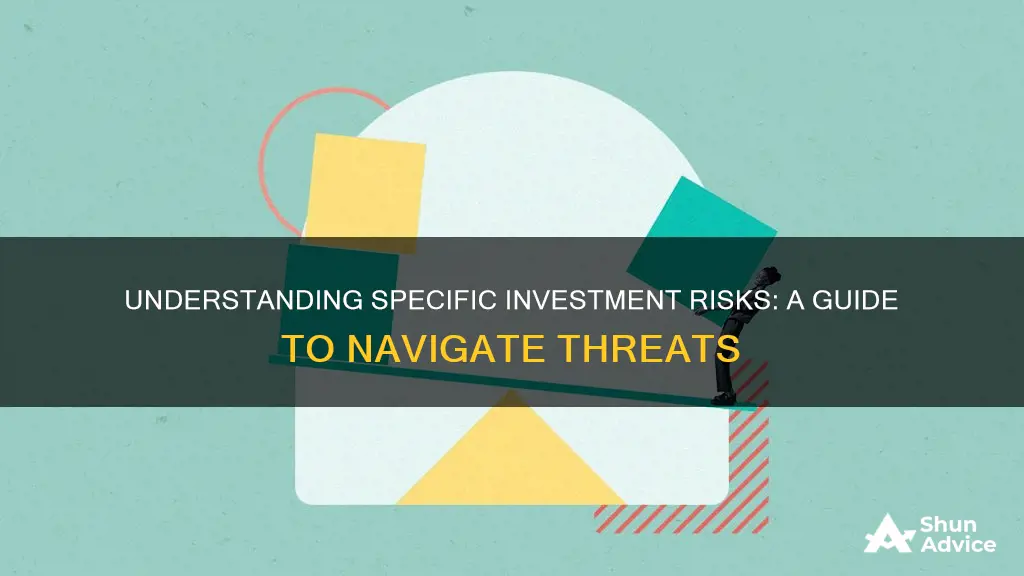
Investment risk can be broadly categorized into two types: systematic risk and unsystematic risk. Systematic risks, also known as market risks, affect an entire economic market or a large percentage of the total market. Unsystematic risk, on the other hand, is unique to a particular company or industry. While it is not possible to eliminate investment risk, it can be managed through strategies such as asset allocation, diversification, hedging, and insurance products.
There are several specific types of investment risks that fall under either systematic or unsystematic risk. These include interest rate risk, market risk, reinvestment rate risk, purchasing power or inflation risk, currency or exchange rate risk, business risk, financial risk, credit risk, downgrade risk, liquidity and marketability risk, and event risk.

Interest rate risk
When interest rates increase, bond prices tend to decrease, and vice versa. This is because the market value of existing bonds adjusts to align with the attractiveness of newly issued bonds offering higher or lower rates. As a result, investors may face opportunity costs as older bonds with lower interest rates become less attractive. Consequently, the market values of such bonds decline.
The extent of interest rate risk depends on the bond's maturity and coupon rate. Longer-term bonds are more susceptible to interest rate fluctuations as investors are locked into a fixed rate for an extended period, making the bond's value more sensitive to interest rate changes. Bonds with lower coupon rates also tend to be more vulnerable to interest rate risk as their lower interest payments become less appealing when rates rise.
Assessing Investment Risk: Strategies for Measuring Success
You may want to see also

Inflation risk
When there is inflation, the average cost of goods and services increases, leading to a decrease in purchasing power. This means that your money "buys less" over time. Inflation can be calculated broadly as the overall increase in the cost of living, or for specific items, such as the cost of gas, groceries, or housing.
Any asset or income stream that is denominated in money is potentially vulnerable to inflation risk because it will lose value in direct proportion to the decline in purchasing power. For example, lending a fixed sum of money to be repaid at a later date is an asset that is subject to inflation risk because the money that is repaid may be worth significantly less than the money that was lent.
Bonds are considered the most vulnerable to inflation risk. Most bonds have a fixed coupon rate that does not increase over time. So, if an investor buys a 30-year bond with a four percent interest rate, but inflation skyrockets to 12%, the investor will be in serious trouble. With each passing year, the bondholder loses more and more purchasing power, regardless of how safe they feel the investment is.
To protect against inflation risk, investors can build an inflation premium into the interest rate or required rate of return (RoR) demanded for an investment. For example, if a lender expects the value of money to decline by 3% in one year, they can add 3% to the interest rate they charge to compensate.
Some securities, such as Treasury Inflation-Protected Securities (TIPS), address inflation risk by adjusting their cash flows according to changes in the consumer price index (CPI). This gives the investor a guaranteed real return based on the actual inflation rate.
Unlocking Home Equity: A Smart Investment Strategy
You may want to see also

Currency risk
For example, an investor in the US who invests in a Canadian stock in Canadian dollars will be exposed to currency risk. Even if the share value increases, they may still lose money if the Canadian dollar depreciates against the US dollar.
To manage currency risk, investors can use hedging strategies such as currency futures, options, or currency hedge funds. Hedging involves taking on one risk to offset another. In the context of currency risk, investors can lock in the current exchange rate by entering into an offsetting currency futures position, thus protecting themselves from potential losses due to unfavourable exchange rate movements.
Unlocking Home Equity: Strategies for Smart Investing
You may want to see also

Liquidity risk
There are two main types of liquidity risk: market liquidity risk and funding liquidity risk. Market liquidity risk occurs when an entity cannot execute transactions at prevailing market prices due to insufficient market depth or disruptions. Funding liquidity risk, on the other hand, refers to the inability to obtain sufficient funding to meet financial obligations.
Effective liquidity risk management is crucial for financial stability and involves maintaining sufficient cash, liquid assets, and accessible borrowing lines to meet both expected and unexpected liquidity needs. Banks and financial institutions are often regulated by frameworks that enforce liquidity standards, such as Basel III, to ensure financial stability and protect depositors.
The consequences of poorly managed liquidity risk can be severe and may lead to financial losses, operational disruptions, and reputational damage. In extreme cases, liquidity risk can even drive an entity towards insolvency or bankruptcy. Therefore, it is essential for investors to carefully consider liquidity risk when making investment decisions.
Hurricane 92L: When Will It Make Landfall?
You may want to see also

Credit risk
Overall, credit risk is an important concept for investors to understand, especially those investing in bonds, as it helps them evaluate the potential for losses and make informed investment decisions.
A Guide to Investing in Indian REITs
You may want to see also
Frequently asked questions
Risk is defined in financial terms as the chance that an investment's actual gains will differ from an expected outcome or return. It includes the possibility of losing some or all of an original investment.
There are two main types of investment risk: systematic risk and unsystematic risk. Systematic risk, also known as market risk, affects entire economic markets or a large percentage of the total market. Unsystematic risk, on the other hand, only affects a specific industry or company.
Investment risk can be managed through regular risk assessment and diversification. Diversification involves spreading your investments across different types of securities, industries, and geographic locations to reduce risk.
Risk and return are connected. Generally, the higher the risk of an investment, the higher the potential return. However, higher risk does not always equate to higher returns, and there are no guarantees.







